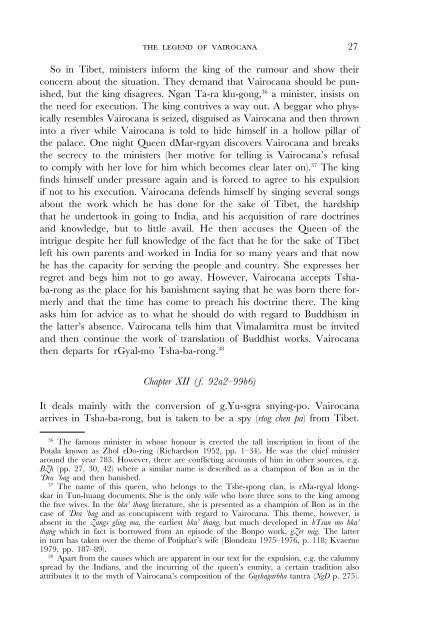Create successful ePaper yourself
Turn your PDF publications into a flip-book with our unique Google optimized e-Paper software.
the legend of vairocana 27<br />
So in Tibet, ministers inform the king of the rumour and show their<br />
concern about the situation. They demand that Vairocana should be punished,<br />
but the king disagrees. Ngan Ta-ra klu-gong, 36 a minister, insists on<br />
the need for execution. The king contrives a way out. A beggar who physically<br />
resembles Vairocana is seized, disguised as Vairocana and then thrown<br />
into a river while Vairocana is told to hide himself in a hollow pillar of<br />
the palace. One night Queen dMar-rgyan discovers Vairocana and breaks<br />
the secrecy to the ministers (her motive for telling is Vairocana’s refusal<br />
to comply with her love for him which becomes clear later on). 37 The king<br />
finds himself under pressure again and is forced to agree to his expulsion<br />
if not to his execution. Vairocana defends himself by singing several songs<br />
about the work which he has done for the sake of Tibet, the hardship<br />
that he undertook in going to India, and his acquisition of rare doctrines<br />
and knowledge, but to little avail. He then accuses the Queen of the<br />
intrigue despite her full knowledge of the fact that he for the sake of Tibet<br />
left his own parents and worked in India for so many years and that now<br />
he has the capacity for serving the people and country. She expresses her<br />
regret and begs him not to go away. However, Vairocana accepts Tshaba-rong<br />
as the place for his banishment saying that he was born there formerly<br />
and that the time has come to preach his doctrine there. The king<br />
asks him for advice as to what he should do with regard to Buddhism in<br />
the latter’s absence. Vairocana tells him that Vimalamitra must be invited<br />
and then continue the work of translation of Buddhist works. Vairocana<br />
then departs for rGyal-mo Tsha-ba-rong. 38<br />
Chapter XII ( f. 92a2–99b6)<br />
It deals mainly with the conversion of g.Yu-sgra snying-po. Vairocana<br />
arrives in Tsha-ba-rong, but is taken to be a spy (rtog chen pa) from Tibet.<br />
36 The famous minister in whose honour is erected the tall inscription in front of the<br />
Potala known as Zhol rDo-ring (Richardson 1952, pp. 1–34). He was the chief minister<br />
around the year 783. However, there are conflicting accounts of him in other sources, e.g.<br />
BZh (pp. 27, 30, 42) where a similar name is described as a champion of Bon as in the<br />
’Dra ’bag and then banished.<br />
37 The name of this queen, who belongs to the Tshe-spong clan, is rMa-rgyal ldongskar<br />
in Tun-huang documents. She is the only wife who bore three sons to the king among<br />
the five wives. In the bka’ thang literature, she is presented as a champion of Bon as in the<br />
case of ’Dra ’bag and as concupiscent with regard to Vairocana. This theme, however, is<br />
absent in the Zangs gling ma, the earliest bka’ thang, but much developed in bTsun mo bka’<br />
thang which in fact is borrowed from an episode of the Bonpo work, gZer mig. The latter<br />
in turn has taken over the theme of Potiphar’s wife (Blondeau 1975–1976, p. 118; Kvaerne<br />
1979, pp. 187–89).<br />
38 Apart from the causes which are apparent in our text for the expulsion, e.g. the calumny<br />
spread by the Indians, and the incurring of the queen’s enmity, a certain tradition also<br />
attributes it to the myth of Vairocana’s composition of the Guyhagarbha tantra (NgD p. 275).

















